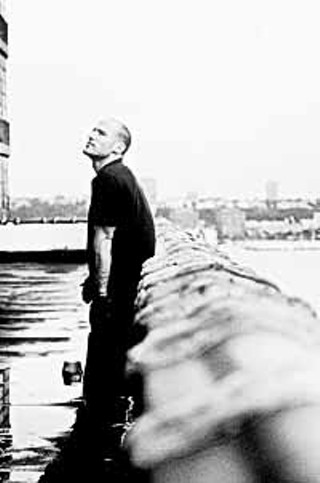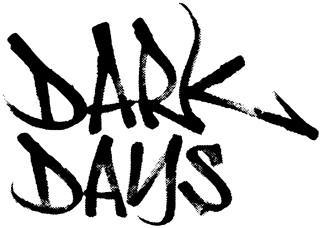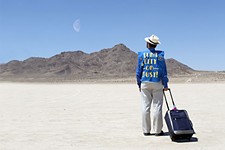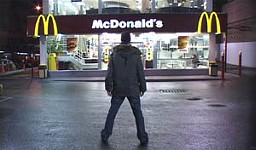Dark Days
How a Manhattan Homeless Community Helped Make the Year's Most Stirring Documentary
By Peter Debruge, Fri., Nov. 10, 2000

Marc Singer may be the man responsible for directing the year's most compassionate and stirring documentary, but he refuses to take credit for the film. As he sees it, Dark Days -- an evocative film about a society of homeless men and women nestled away in total darkness beneath Manhattan's Amtrak tunnel system -- belongs to his crew, the folks who actually inhabited the tunnels and helped him film their story.
Singer brought Dark Days to Austin last spring for the SXSW Film Festival, where it received an award for Senior Programmers' Pick (after winning the Audience Award at Sundance). The documentary returns this Friday for its long-anticipated theatrical run at the Dobie Theatre. At the festival, I met with Singer to discuss his contribution to the film. With his head ducked shyly and hands constantly fidgeting, Singer explained the story behind Dark Days with the same soft-spoken modesty that marks the film.
At age 17, Marc Singer left London and moved to America after finding himself "going down the wrong path and experimenting a little bit too much with different things. I wanted a fresh start." Years later, Singer brought that experience to Dark Days, along with his faith that people -- even those in the harshest circumstances -- could improve their lives when given a second chance.
After reaching America, Singer tried school for a year and even entertained a brief career as a fashion model in Miami. Disillusioned by some of his experiences, he moved to New York City, where talk of alligators in the sewers and homeless people living beneath the streets piqued his interest.
"I was fascinated by what it must be like to be homeless, so I just started hanging out with some people in my neighborhood in New York who were living on the street, helping them out however I could," Singer says. "One of them would tell me about the tunnels. When you're on the street, you hear different stories about different things. I kept hearing all this crazy stuff, so I decided to go exploring to see if the tunnel rumors really matched what everyone was talking about."
In the beginning, Singer ventured into as many tunnels as he could, though the community he discovered living in one particular tunnel -- the same people who would eventually allow him to film their story -- struck him as different. "It was nice as far as tunnels go, if that makes any sense," he says. "It just had the best variety of people in it. There was a really big mix, and the people had really done well for themselves for being homeless, more than in the other tunnels. They had built themselves these houses and all these different things. I was in awe of everybody, really. I had so much respect for them because I used to think, 'If I was homeless, would I be able to do the same thing?'
"When you're walking by every day, you don't really want to know what it's about. Your own life is sometimes hard enough that it seems impossible to think about helping other people. At the time, I happened to be fortunate enough that things were going well for me."
Singer would go down to the tunnels just to hang out and make friends with the people he met there. As time passed, he started getting to know the residents and began considering ways to get them out of the tunnels. The notion that a documentary might bring attention to the tunnels and help the people living there find homes of their own didn't even cross Singer's mind until two or three months after his first visit. Even then, Singer claims that he wasn't the one who first proposed the idea.

"I was talking to Ralph one day, one of the characters, and we both said, 'You know, somebody should be making a film about this.' Not only was it fascinating, but it could hopefully make a difference, too. Even if all it did was make people not look with so much hate toward people on the street, it would be a good, worthwhile thing to do," he says. "They're good people, and as much as people fuck up, it was almost like they were being punished. There's not one positive thing that comes from living on the street, but it's almost impossible to get out without help."
Unfortunately, no one really had the money to finance Singer's film. Such a minor snag hardly even mattered in comparison with a significantly more daunting obstacle: Singer had never used a film camera before and had no idea how to make a movie. Undeterred, he managed to find a production directory and visited the first camera shop on the list, a place called Cinevision, where a man named Lowry Dreke taught him how to load a camera.
Drake humored Singer about his vision -- some outrageous idea for a documentary in which the homeless subjects would double as the film crew -- and demonstrated as much as he could about the camera equipment Singer would need. As Singer remembers it, he could only afford to pay a couple hundred dollars, promising to make up the rest later. Cinevision still supplied him with cameras for the next two and a half years.
"The camera would get beaten up in the tunnel," Singer says. "It's so dusty down there, if you were to shine a flashlight, all you would see is dirt in the beam. The tunnel's hard-core, dirt-wise, so those cameras we'd get, they'd take a beating. I just kept bringing them back, and he just kept giving me new ones."
Singer tried to adapt everyone's talents to a position on the crew. Henry, who powered his house by hooking into street lights up above, served as the production's electrician. He tapped into a city power box 30 blocks away and ran cords all the way back to the tunnel. In such utter darkness, even a single bulb could transform the whole environment and provide enough light for shooting. Some of the people had never seen their houses lit by anything more than candles before the camera crew started filming. At another point, Singer turned to Henry for advice on using the adjacent railway tracks to their advantage. Singer explained that he wanted to film a moving shot along a straight stretch of tunnel where the houses were lined up to look like a street. A day later, Henry had rigged a makeshift dolly using parts from an old shopping cart, which they used to capture one of the film's most professional-looking images.
"There's a lot of reasons that I wanted them to be the crew," Singer explains. "Being on the street, you lose a lot of your self-esteem and your self-respect. Considering all of the other things that internally happen to you, you're really quite shattered. Being the crew on the film gave people a lot of that confidence back. It's a difficult thing to make a film, and yet they were doing this thing that you're supposed to be really educated in. That really brought people to life again.
"Also, I wanted to help them get themselves out of the tunnel. If the film was going to do that, they had to be a part of it. It would also teach people to work in a group again, work as a team, because they're gonna be back in the work force and they've got to be able to work with people. In the beginning, it was a little difficult because none of us had a clue, but after three or four weeks, they would say to me, 'Where are you going to film tonight?' and I'd get there and the cameras would be loaded, sound ready, lights ready, everyone's like a full working group. It was amazing."
None of the people involved -- least of all Singer -- knew what he was doing, yet they committed themselves to the goal anyway. They had gone through 30 hours of footage before taking the film to a lab to be developed, not even sure that any of what they had shot would come out. When Singer ran out of funds to buy film, one of the guys at the lab called up Kodak, who provided him with free film. Meanwhile, at least during the early days, Singer's roommates encouraged the project, telling him they would help cover his rent.
"I had a little house down there in the tunnel, but it didn't last very long," he says. After Dee, a woman living in the tunnel, lost her house to a fire, Singer gave her the wood from his own place. "And so at that point, I ended up sleeping around at a few different people's houses, which was great. I still had a place I could go if I wanted to go outside of the tunnel, but things started getting tougher after shooting. There came a point where I didn't have a choice, and I ended up staying with everybody from the tunnel. They'd all laugh at me, 'Ah, look at you now! You went from taxi cabs and sushi to the subway and McDonald's to the garbage and walking.'

"It was a give and take. If I had money, everybody was going to eat good. But if I didn't have money, they would help me. There was a six-month stretch where, if they didn't feed me or I hadn't gone out and gotten food with them, I wouldn't have eaten."
From time to time, television crews would come down in search of sound bites (even Jerry Springer once visited a neighboring tunnel), but the tunnel residents would either say exactly what the journalists expected to hear or try to make them uncomfortable until they left. Meanwhile, Singer was actually living among the homeless, recording facets of the lifestyle that never appear on the evening news. In some ways, the film gave these homeless people something to do, something to dream about as they sat around the fires at night.
"One of the other sad parts about being homeless is that it's fucking boring as hell," Singer says. "You don't have the freedom to do anything else apart from survive. And surviving is very basic: food, shelter, and hygiene. That's pretty much it. These guys do the same shit every day. Like Greg is going to cook a meal for the rats with poison almost every other day. He's going to take a shower every day. If Ralph and Dee start an argument, two weeks later, they're still going to be arguing."
But Singer doesn't want the film to make us feel guilty that we are living comfortably while somebody else is on the street. Though the setting is grim and the circumstances find people at the most desperate point in their lives, Singer focuses on the positive things people try to do for themselves. Though the behavior he shows may be illegal -- whether filming drug use or people who were on the run from the police -- he felt that some of these moments most accurately reflected the way the homeless coped with their situation.
"I was always very careful," Singer said. "I never took anybody down there, ever. I wasn't going to be a fucking tour guide, and they definitely weren't going to be on show. I fucking hate it when you're watching a socially conscious documentary and you see somebody dying there and the person is just filming thinking, 'I'm getting a great shot here.' I don't think you can not get involved if you're doing something like this.
"If I had the chance to film something or help someone, I was going to help them every time. Somebody could be sitting on the tracks, and you know if they sit there long enough, they're gonna get hit by the train. Now do I sit there and wait to film the guy, or do I put the camera down and get him off the tracks and then spend three hours trying to talk him out of doing it?"
Singer spent nearly a year and a half in the tunnels -- sometimes, he would film every day; at other times, he would put the camera down for a few months just trying to keep his friends company -- before the police came down to clean out the homeless. At that point, a photographer named Margaret Morton, who had been taking pictures of the homeless for years, went to the Coalition for the Homeless, encouraging them to file an injunction against Amtrak to protect the people living in the tunnels.
Over the next 10 months, both Morton and Singer devoted themselves entirely to assigning housing vouchers released by the Department of Housing and Urban Development to those living in tunnels. One by one, the people living in the tunnels cleaned up and moved out. These days, Singer can hardly believe that he can use e-mail to keep in contact with friends who once lived without electricity, that they can meet for meals in restaurants.
But even after his friends had moved from the tunnels to apartments of their own, Singer faced further obstacles: tracking down finishing funds, editing the film, and convincing DJ Shadow to let them use his music in the score. But Singer persisted, carefully assembling a portrait that reflects the faces he encountered in the tunnel without ever revealing his own. Even to the end, Singer insists on letting the homeless speak for themselves, masking his presence from a project that consumed nearly six years of his life.
"This film is not about me. If you start [privileging your point of view], you put people on a different level than yourself, most of the time beneath you, and that's not how it is. They're people. At some point in the film, you forget that they're homeless because their conversations and concerns -- like haircuts or the loss of a cup -- are so normal. That was the point of the whole film, to show that they are normal people. They just don't have a place to live. But their concerns and their fears, their hopes and their dreams are exactly the same." ![]()
Dark Days opens Friday, Nov. 10, for a limited run at the Dobie Theatre. See review on our Movie Guide.
"Art From the Streets" is an annual show and sale featuring the art of homeless men and women who are clients at Austin's Resource for the Homeless (ARCH). It runs Saturday-Sunday, Nov. 18-19, noon-5pm, at 701 W. Fifth, inside ARCH. $25 and up for original work; all sale proceeds go to the artists. $1 donation requested for admission. For more information, call 440-0839.










